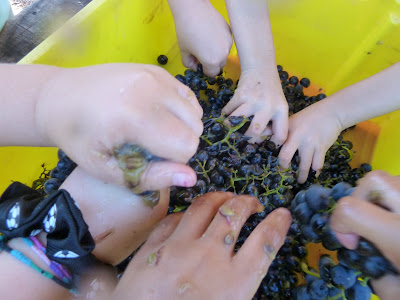I remember tasting a peach from a tree at the Student Farm at UC Davis. It was the best thing I had ever tasted in my life up until then. Then there were the heirloom tomatoes, the freshly dug potatoes, the enormous variety of melons, including yellow and Moon&Stars watermelons, and it went on from there.
I had been a very picky eater most of my life, but that chapter of my life was over once I discovered the explosion of flavors from food that hadn't spent too much time on the produce shelf or had been overly processed. Though it was several years before the term "foodie" was coined, that's what I became after that first summer in Davis.
 |
| Annie Main from Good Humus Produce at the Davis Farmers' Market |
 |
| A younger Steve harvesting basil, destined for pesto, from our garden in Davis. |
After finishing graduate school, I became an active promoter of Sustainable Agriculture through my many years working for a non-profit organization and successfully getting mainstream farmers to farm more sustainably.
When I met Steve, he had been an avid gardener and had a community garden plot
Neither of us grew up with any exposure to wine beyond box and jug wines, but Steve got to experience some great wines during visits to a friend's family home while in college. Steve was excited to explore new wines and quickly got me hooked. We visited wineries and started making wine ourselves in our backyard. I always joked that we were co-dependant foodies, always trying to one-up each other's crazy ideas about food preservation.
We came to expect easy access to fresh, locally grown food, but when we moved to Napa, in 2002, we were surprised at how little there was to offer. We didn't have space for a very big garden, so we were starved for the fresh veggies and fruits that were abundant in Davis. Since many of our organic farmer friends were selling their produce in the San Francisco Bay Area, we thought that the organic farming "movement" was bigger than it turned out to be. Those of us insisting on good quality food were still in a very small minority...Steve and I were just too involved to have perspective.
 |
| Matthiasson Family at the Napa Farmers' Market |
Always sharing the dream of farming, we had the opportunity to plant a fruit orchard on a friends property in Napa in 2004. Since it was rare to find locally grown fruit in Napa, we thought it would be easy to find a market for our peaches, plums, nectarines, etc. But we were mistaken. Only a couple of Napa restaurants/chefs – Zuzu and Chef Peter Pahk – were interested in what we had to offer. We struggled to sell everything that we could produce, so once again we started to can, freeze, and make lots of jam.
But I am happy to say that over the last five years or so, we've seen a big change. Restaurants in Napa like Oenotri, Norman Rose, Azzurro Pizzeria, and ABC Bakery have become regular peach buying customers and our sales at the Napa Farmers' Market are brisk. Several Napa Valley restaurants have their own gardens, and interest in local food seems to have taken hold.
I'm also very encouraged as I travel around the country selling wine. In mid-sized cities, such as Denver, Charleston, and Salt Lake City, where only five years ago there were a handful of high-end restaurants, mostly steak houses, there is now a profusion of great restaurants focusing on local food.
 |
| The Menu from a dinner featuring Matthiasson Wines at Linger Restaurant in Denver |
We have seen the same change in the interest in our wine. New York Times wine critic, Eric Asimov, said about us "their wines bear an agricultural stamp, as fresh, lively and alive as the best produce from a farmers’ market." Our wines go with the food we grow; they aren't typical steakhouse Napa Cabs. With the proliferation of restaurants and consumers insisting on locally grown food and wines that match, I feel that we are part of a burgeoning food and wine renaissance.
After promoting local food for so many years, it's very gratifying to witness this change. Because of my background, several young people just out of college contact and visit us looking for advise on how to get on the path of farming and winemaking that we are on.
We have been able to stay on this path because of folks like you. I am excited about the direction things are going in the food and wine worlds.
Thanks and keep it up!
Jill







































